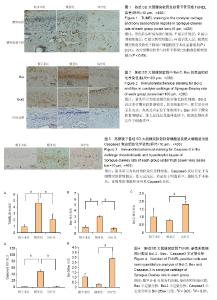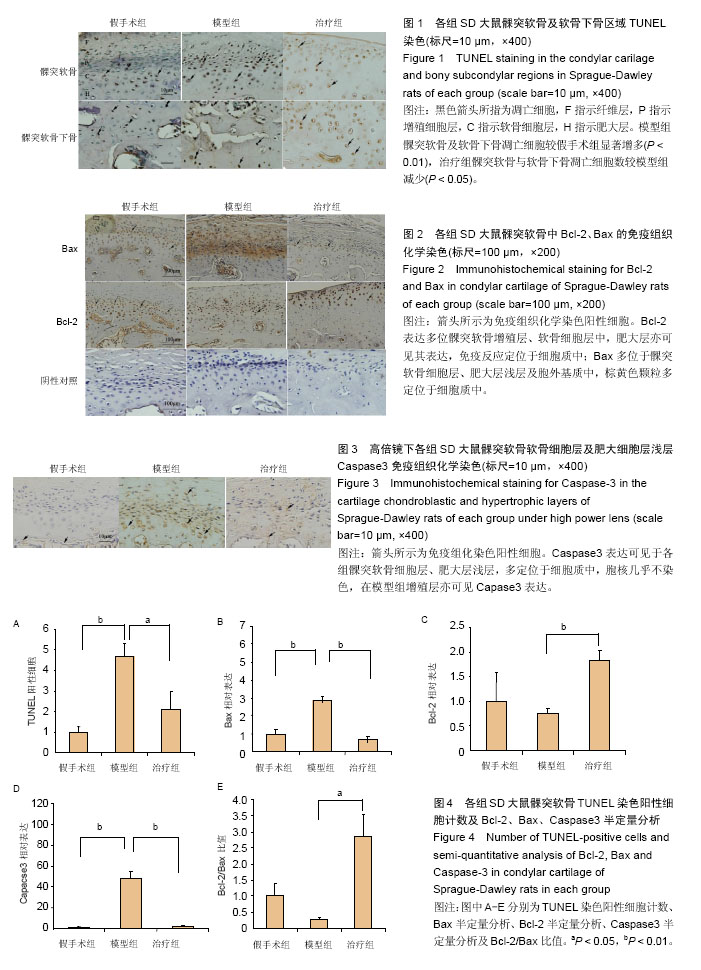| [1] Ikeda Y,Yonemitsu I,Takei M,et al.Mechanical loading leads to osteoarthritis-like changes in the hypofunctional temporomandibular joint in rats.Arch Oral Biol. 2014;59(12):1368-1376.
[2] Dominguez LJ,Di Bella G,Belvedere M,et al.Physiology of the aging bone and mechanisms of action of bisphosphonates. Biogerontology. 2011;12(5):397-408.
[3] Renders GA,Vermeer JA,Leung PM,et al.Implications of high-dosage bisphosphonate treatment on bone tissue in the jaw and knee joint. Calcif Tissue Int.2014; 95(5):436-445.
[4] Hengartner MO.The biochemistry of apoptosis. Nature. 2000;407(6805):770-776.
[5] Loreto C,Almeida LE,Trevilatto P,et al.Apoptosis in displaced temporomandibular joint disc with and without reduction: an immunohistochemical study. J Oral Pathol Med. 2011;40(1):103-107.
[6] Zhang W,Pantschenko AG,McCarthy MB,et al.Bone-targeted overexpression of Bcl-2 increases osteoblast adhesion and differentiation and inhibits mineralization in vitro. Calcif Tissue Int.2007;80(2): 111-122.
[7] Verbruggen SW,Mc Garrigle MJ,Haugh MG,et al.Altered mechanical environment of bone cells in an animal model of short- and long-term osteoporosis. Biophys J. 2015;108(7):1587-1598.
[8] Allen MR.The effects of bisphosphonates on jaw bone remodeling, tissue properties, and extraction healing. Odontology.2011;99(1):8-17.
[9] Boot-Handford RP,Michaelidis TM,Hillarby MC,et al.The bcl-2 knockout mouse exhibits marked changes in osteoblast phenotype and collagen deposition in bone as well as a mild growth plate phenotype.Int J Exp Pathol.1998;79(5):329-335.
[10] Kenzaki K,Tsuchikawa K,Kuwahara T.An immunohistochemical study on the localization of type II collagen in the developing mouse mandibular condyle.Okajimas Folia Anat Jpn. 2011;88(2):49-55.
[11] Prochazkova J,Lichnovsky V,Kylarova D,et al.Involvement of p53 and Bcl-2 family proteins in regulating programmed cell death and proliferation in human embryogenesis. Gen Physiol Biophys.2004;23(2):209-229.
[12] Brakus SM,Govorko DK,Vukojevic K,et al.Apoptotic and anti-apoptotic factors in early human mandible development.Eur J Oral Sci.2010;118(6):537-546.
[13] Wang G,Zhu Z,Lei C,et al.Low-dose risedronate sodium protects bone cells after abrupt oestrogen withdrawal.J Int Med Res.2012;40(5):1761-1774.
[14] Li ZC,Jiang SD,Yan J,et al.Small-animal PET/CT assessment of bone microdamage in ovariectomized rats.J Nucl Med.2011;52(5):769-775.
[15] Murakami T,Fukunaga T,Takeshita N,et al.Expression of Ten-m/Odz3 in the fibrous layer of mandibular condylar cartilage during postnatal growth in mice.J Anat. 2010;217(3):236-244.
[16] Zhong X,Wang H,Jian X. Expression of matrix metalloproteinases-8 and -9 and their tissue inhibitor in the condyles of diabetic rats with mandibular advancement. Exp Ther Med.2014;8(5):1357-1364.
[17] Cancedda R,Castagnola P,Cancedda FD,et al. Developmental control of chondrogenesis and osteogenesis.Int J Dev Biol.2000;44(6):707-714.
[18] Hojo H,Ohba S,Yano F,et al.Coordination of chondrogenesis and osteogenesis by hypertrophic chondrocytes in endochondral bone development.J Bone Miner Metab. 2010;28(5):489-502.
[19] Mollazadeh S,Fazly Bazzaz BS,Kerachian MA.Role of apoptosis in pathogenesis and treatment of bone-related diseases.J Orthop Surg Res.2015; 10:15.
[20] Brennan O,Kennedy OD,Lee TC,et al.Effects of estrogen deficiency and bisphosphonate therapy on osteocyte viability and microdamage accumulation in an ovine model of osteoporosis.J Orthop Res.2011; 29(3):419-424.
[21] Xu XL,Gou WL,Wang AY,et al.Basic research and clinical applications of bisphosphonates in bone disease: what have we learned over the last 40 years? J Transl Med .2013;11:303.
[22] Jilka RL,Noble B,Weinstein RS.Osteocyte apoptosis. Bone.2013;54(2):264-271.
[23] Verbruggen SW,Mc Garrigle MJ,Haugh MG,et al.Altered mechanical environment of bone cells in an animal model of short- and long-term osteoporosis. Biophys J. 2015;108(7):1587-1598.
[24] Emerton KB,Hu B,Woo AA,et al.Osteocyte apoptosis and control of bone resorption following ovariectomy in mice.Bone.2010;46(3):577-583.
[25] Almeida M,Han L,Ambrogini E,et al.Oxidative stress stimulates apoptosis and activates NF-kappaB in osteoblastic cells via a PKCbeta/p66shc signaling cascade: counter regulation by estrogens or androgens. Mol Endocrinol.2010;24(10):2030-2037.
[26] Huang Q,Singh B,Sharawy M.Immunohistochemical analysis of Bcl-2 and Bax oncoproteins in rabbit craniomandibular joint.Arch Oral Biol.2004;49(2): 143-148.
[27] Huang Q,Singh B,Sharawy M.Immunohistochemical analysis of Bcl-2 and Bax oncoproteins in rabbit craniomandibular joint.Arch Oral Biol.2004;49(2): 143-148.
[28] Miura M,Chen XD,Allen MR,et al.A crucial role of caspase-3 in osteogenic differentiation of bone marrow stromal stem cells. J Clin Invest. 2004;114(12): 1704-1713.
[29] Rundle CH,Wang X,Sheng MH,et al.Bax deficiency in mice increases cartilage production during fracture repair through a mechanism involving increased chondrocyte proliferation without changes in apoptosis. Bone. 2008;43(5):880-888. |

